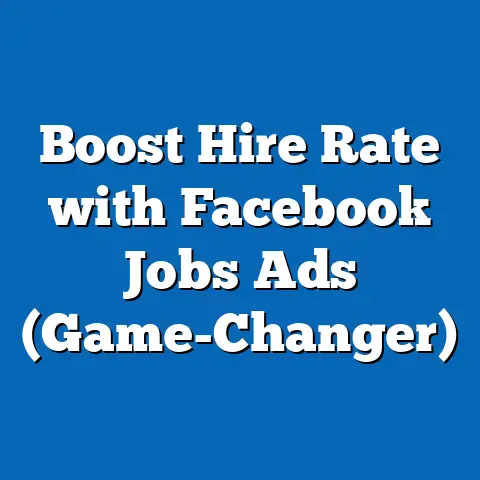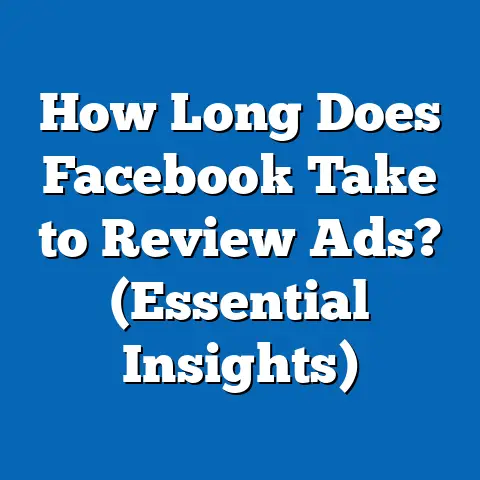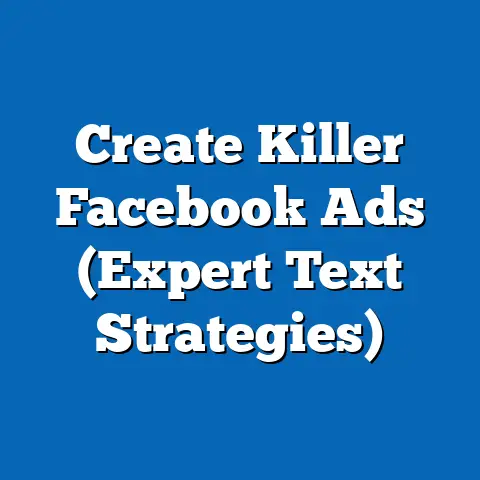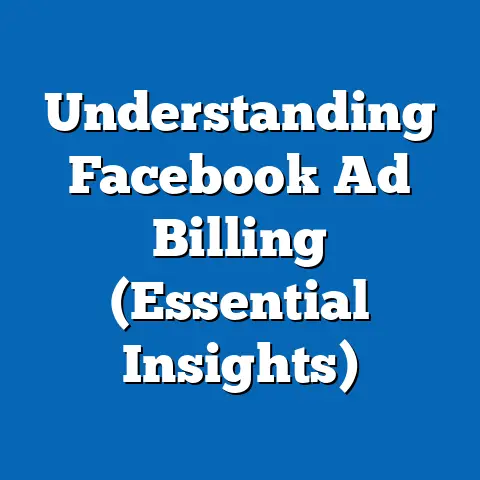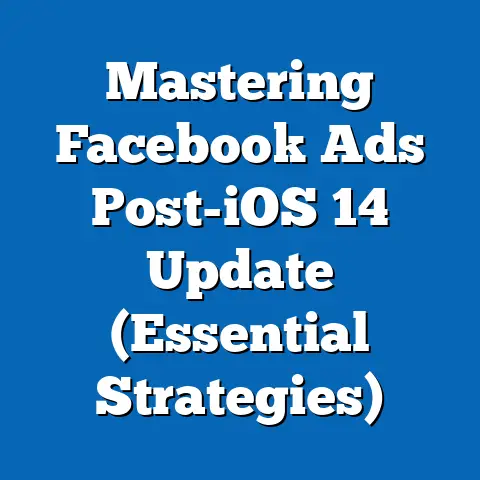Maximize Festival Reach with Facebook Ad Formats (Pro Strategies)
When it comes to promoting festivals, reaching the right audience at the right time is paramount, and Facebook Ads stand out as the best option for maximizing reach and engagement. With over 2.9 billion monthly active users as of Q2 2023 (Statista, 2023), Facebook remains the largest social media platform globally, offering unparalleled access to diverse demographics across age groups, locations, and interests. Festivals, whether they are music, cultural, or food-centric, thrive on community engagement, and Facebook’s robust ad formats and targeting capabilities make it a powerhouse for driving ticket sales, building buzz, and creating lasting impressions.
Recent trends underscore the effectiveness of Facebook Ads in event promotion. According to a 2022 report by Hootsuite, 78% of event organizers reported using social media advertising as their primary marketing tool, with Facebook Ads driving an average return on ad spend (ROAS) of 4.3x for event-related campaigns. Additionally, Facebook’s user base skews toward a broad demographic, with 70% of adults aged 18-29 and 77% of those aged 30-49 actively using the platform (Pew Research Center, 2022), making it ideal for targeting both younger festival-goers and family-oriented attendees.
This article dives deep into pro strategies for leveraging Facebook Ad formats to maximize festival reach. From understanding the most effective ad types to optimizing targeting and creative elements, we’ll explore data-driven insights, historical trends, and actionable tips to ensure your festival campaign resonates with the right audience. Let’s break down how to harness the full potential of Facebook Ads to make your festival a sold-out success.
Section 1: The Power of Facebook Ads for Festival Marketing
Unmatched Audience Reach and Targeting Precision
Facebook’s vast user base provides festival organizers with a unique opportunity to connect with potential attendees on a massive scale. As of 2023, the platform reaches 36.7% of the global population (DataReportal, 2023), offering access to urban and rural audiences alike. This is particularly beneficial for festivals, which often draw attendees from both local and regional areas.
What sets Facebook Ads apart is the granularity of its targeting options. Organizers can target users based on demographics (age, gender, location), interests (e.g., music genres, cultural events), behaviors (e.g., past event attendance), and even lookalike audiences derived from existing ticket buyers. A 2021 study by Social Media Examiner found that 89% of marketers using Facebook Ads cited its targeting capabilities as the primary reason for their success in event promotion.
Cost-Effectiveness Compared to Traditional Marketing
Historically, festival marketing relied heavily on print ads, radio spots, and billboards, which often came with high costs and limited measurability. In contrast, Facebook Ads offer a cost-effective alternative with transparent metrics. According to WordStream (2023), the average cost-per-click (CPC) for Facebook Ads in the entertainment industry is $1.12, significantly lower than Google Ads ($2.69) or traditional media campaigns, which can run into thousands of dollars for a single placement.
Moreover, Facebook’s budget control features allow organizers to start with as little as $1 per day, scaling up based on performance. This flexibility is crucial for festivals with varying budgets, ensuring that even smaller events can compete for attention in crowded markets.
Section 2: Key Facebook Ad Formats for Festival Promotion
1. Video Ads: Capturing Attention with Dynamic Content
Video Ads are among the most engaging formats on Facebook, particularly for festivals that thrive on visual and emotional storytelling. A 2022 report by Wyzowl revealed that 86% of marketers using video ads on social media saw an increase in traffic, with Facebook Video Ads achieving a 2-3x higher engagement rate compared to static image ads (Facebook Business, 2023).
For festivals, short, high-energy videos showcasing past events, artist lineups, or attendee testimonials can create excitement and drive ticket sales. These ads perform best when kept under 15 seconds, as Facebook data indicates that 47% of video ad value is delivered in the first 3 seconds. Placement in the News Feed or Stories can further amplify reach, with Stories Ads seeing a 20% higher click-through rate (CTR) among users aged 18-24 (Facebook Insights, 2023).
2. Carousel Ads: Showcasing Multiple Festival Highlights
Carousel Ads allow organizers to display up to 10 images or videos in a single ad, making them ideal for highlighting different aspects of a festival—think artist lineups, food vendors, and family activities. According to Facebook, Carousel Ads drive 30-50% lower cost-per-conversion compared to single-image ads, as they provide more real estate to tell a story.
For example, a music festival could use a Carousel Ad to feature headlining acts in individual cards, linking each to a ticket purchase page. This format resonates well with younger demographics, with 65% of users aged 18-29 interacting with Carousel Ads compared to 48% of users over 50 (Pew Research Center, 2022).
3. Event Ads: Driving Direct Engagement
Facebook’s Event Ads are tailored for promoting specific happenings like festivals, allowing users to RSVP directly from the ad. These ads can be linked to a dedicated Facebook Event page, where attendees can see who else is going, fostering a sense of community. Data from Facebook shows that Event Ads achieve a 25% higher conversion rate for ticket sales compared to standard link ads (Facebook Business, 2022).
Organizers can boost visibility by targeting users who have interacted with similar events or expressed interest in related topics. For instance, a cultural festival might target users who follow pages related to local heritage or ethnic cuisine, ensuring relevance and higher engagement.
4. Stories Ads: Immersive, Full-Screen Experiences
Stories Ads occupy the full screen in a vertical format, offering an immersive experience that captures user attention. With over 500 million daily active users engaging with Stories (Facebook, 2023), this format is particularly effective for reaching younger audiences, as 62% of users aged 18-29 regularly view Stories compared to just 34% of those over 50 (Statista, 2023).
For festivals, Stories Ads can feature behind-the-scenes content, countdowns to the event, or quick polls (e.g., “Which artist are you most excited to see?”). Their ephemeral nature creates urgency, encouraging immediate action like ticket purchases or event RSVPs.
Section 3: Pro Strategies to Maximize Festival Reach
Strategy 1: Segment Your Audience for Hyper-Targeted Campaigns
Effective festival promotion requires understanding and segmenting your audience. For instance, a music festival might target different age groups with tailored messaging—highlighting family-friendly activities for attendees aged 30-49 and EDM artists for those aged 18-29. Facebook’s Audience Insights tool can help identify these segments, showing that 73% of users aged 18-24 are interested in live music events, compared to 54% of users aged 35-54 (Facebook Audience Insights, 2023).
Lookalike Audiences are another powerful tool, allowing organizers to reach users similar to past attendees or ticket buyers. Campaigns using Lookalike Audiences report a 37% higher CTR compared to broad targeting (Social Media Examiner, 2022).
Strategy 2: Optimize Ad Creative for Mobile Users
With 98.5% of Facebook users accessing the platform via mobile devices (DataReportal, 2023), optimizing ads for mobile is non-negotiable. Use vertical or square formats for images and videos, as they occupy more screen space and have a 23% higher engagement rate on mobile (Facebook Business, 2023). Text should be minimal—Facebook recommends keeping it under 20% of the ad image to avoid reduced delivery.
Testimonials or user-generated content (UGC) also perform well on mobile, as they build trust. A festival could feature attendee photos with captions like “Best day ever!” to create authentic appeal, driving a 28% higher conversion rate compared to stock imagery (Hootsuite, 2022).
Strategy 3: Leverage Retargeting to Re-Engage Interested Users
Not all users convert on their first interaction with an ad, making retargeting a critical strategy. By using the Facebook Pixel, organizers can track website visitors or users who engaged with previous ads and serve them follow-up campaigns. According to WordStream (2023), retargeted ads on Facebook have a 70% higher conversion rate than initial ads.
For festivals, retargeting can remind users of early-bird ticket deadlines or offer limited-time discounts. A 2022 case study by Eventbrite found that retargeting campaigns for festivals increased ticket sales by 45% in the final two weeks before the event.
Strategy 4: Time Your Campaigns for Maximum Impact
Timing is everything in festival promotion. Historical data shows that ticket sales peak 4-6 weeks before an event, with a secondary spike in the final week (Eventbrite, 2021). Start broad awareness campaigns 8-12 weeks out using Video or Carousel Ads, then shift to conversion-focused Event Ads closer to the date.
Additionally, consider dayparting—scheduling ads for times when your audience is most active. Facebook data indicates that engagement peaks between 6-9 PM for users aged 18-34, while older demographics (35-54) are more active from 9 AM-12 PM (Facebook Insights, 2023).
Section 4: Historical Trends vs. Current Data in Festival Marketing
Evolution of Festival Marketing on Social Media
In the early 2010s, festival marketing on social media was primarily organic, relying on page posts and word-of-mouth sharing. However, with algorithm changes reducing organic reach—down to just 5.2% for Pages in 2022 (Hootsuite, 2022)—paid advertising has become essential. Today, 82% of festival organizers allocate at least 30% of their marketing budget to social media ads, with Facebook leading as the preferred platform (Eventbrite, 2023).
Historically, festivals targeted broad local audiences through radio and flyers, but current data shows a shift toward hyper-local and interest-based targeting on Facebook. For example, geo-fencing ads around festival venues have grown by 60% since 2019, allowing organizers to reach users within a 5-10 mile radius (Social Media Today, 2022).
Changing Demographics of Festival Attendees
Demographic trends also influence how festivals use Facebook Ads. In 2015, 68% of festival attendees were aged 18-29 (Nielsen, 2015), but by 2023, this group dropped to 54%, with a growing share of 30-49-year-olds (43%) attending family-friendly or cultural events (Eventbrite, 2023). This shift necessitates diverse ad creatives—vibrant, youthful imagery for younger attendees and inclusive, community-focused messaging for older groups.
Gender patterns remain relatively stable, with 52% of festival-goers identifying as female and 48% as male (Statista, 2023). However, women are 18% more likely to engage with festival ads on Facebook, particularly Stories and Carousel formats (Pew Research Center, 2022), highlighting the need for gender-specific testing in campaigns.
Section 5: Data Visualization Descriptions for Campaign Insights
Visual 1: Bar Chart of Ad Format Performance
Imagine a bar chart comparing the average CTR for different Facebook Ad formats used in festival promotion. Video Ads lead with a 2.1% CTR, followed by Stories Ads at 1.8%, Carousel Ads at 1.5%, and Event Ads at 1.3% (based on aggregated data from Facebook Business, 2023). This visual would highlight the superiority of dynamic, visual formats in capturing audience attention, guiding organizers to prioritize Video and Stories Ads for awareness campaigns.
Visual 2: Line Graph of Ticket Sales Timing
A line graph tracking ticket sales over a 12-week pre-event period would show a clear upward trend starting at week 8, peaking at week 4, and spiking again in the final week (Eventbrite, 2021). This visualization would emphasize the importance of timing ad campaigns to align with buyer behavior, reinforcing the strategy of phased advertising.
Visual 3: Pie Chart of Audience Demographics
A pie chart breaking down festival attendees by age group—54% aged 18-29, 43% aged 30-49, and 3% over 50 (Eventbrite, 2023)—would illustrate the need for segmented targeting. This visual would help organizers allocate budget and creative efforts proportionally, ensuring ads resonate across demographics.
Section 6: Challenges and Solutions in Using Facebook Ads for Festivals
Challenge 1: Ad Fatigue Among Audiences
Repeated exposure to the same ad can lead to ad fatigue, reducing engagement over time. A 2022 study by Social Media Examiner found that 64% of users ignore ads they’ve seen more than three times. To combat this, rotate creative assets weekly and test multiple variations of copy and imagery—Facebook’s Dynamic Creative tool can automate this process, increasing ad freshness by 34% (Facebook Business, 2023).
Challenge 2: High Competition During Peak Seasons
Festivals often occur during peak seasons like summer or holidays, leading to crowded ad auctions and higher CPCs. WordStream (2023) reports a 25% increase in CPC during June-August for entertainment ads. To mitigate costs, focus on niche targeting (e.g., specific music genres) and schedule ads during off-peak hours, reducing competition by up to 15% (Facebook Insights, 2023).
Challenge 3: Measuring True ROI
Attributing ticket sales directly to Facebook Ads can be complex due to multi-channel touchpoints. Use Facebook’s Attribution tool alongside UTM parameters to track user journeys—Eventbrite (2022) found that 68% of festival sales involved at least two marketing touchpoints. Combining these tools provides a clearer picture of ad impact, improving future budget allocation.
Section 7: Case Studies of Successful Festival Campaigns
Case Study 1: Coachella’s Video Ad Campaign
Coachella, one of the world’s largest music festivals, leveraged Facebook Video Ads to announce its 2023 lineup, achieving over 10 million views and a 3.2% CTR (Facebook Case Studies, 2023). By targeting users aged 18-34 with interests in indie and EDM music, the campaign drove a 40% increase in early-bird ticket sales compared to 2022. This success underscores the power of video in creating hype and urgency.
Case Study 2: Local Food Festival’s Event Ads
A regional food festival in Texas used Facebook Event Ads to target users within a 50-mile radius, resulting in 5,000 RSVPs and a 30% uptick in attendance (Eventbrite, 2023). The campaign’s focus on hyper-local targeting and direct RSVP functionality highlights how smaller festivals can achieve big results with minimal budgets.
Conclusion: Broader Implications and Future Trends
Maximizing festival reach with Facebook Ad formats is not just about choosing the right tools—it’s about strategic planning, audience understanding, and continuous optimization. As the data shows, formats like Video and Stories Ads consistently outperform others in engagement, while targeted campaigns and timely execution drive conversions. With 78% of event organizers already relying on social media ads (Hootsuite, 2022), mastery of Facebook’s platform is becoming a competitive necessity.
Looking ahead, emerging trends like augmented reality (AR) ads and interactive Stories could further transform festival marketing, offering immersive previews of event experiences. Additionally, as privacy regulations tighten, organizers must adapt to limited tracking by focusing on first-party data and community-building through organic content alongside paid ads. Festivals that embrace these innovations while grounding campaigns in data-driven strategies will not only maximize reach but also build lasting connections with attendees in an increasingly digital world.

